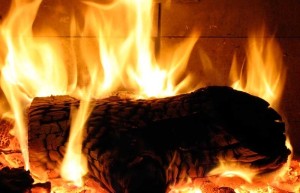The single most important step to take towards fireplace safety is to call a professional chimney sweep for an annual cleaning. They will sweep out soot and debris, remove any rocky or waxy creosote that has accumulated, and inspect both your chimney and fireplace. Trained to spot and repair cracks in mortar and problems with flashing as well as myriad other structural defects, chimney sweeps have vast knowledge about chimneys.

The top of the chimney should be checked to insure that its cap has not been blown away by strong winds. The cap and crown should be examined for rusting or deterioration, and neither birds nor critters should be nesting in your chimney. Moss and mold should not be growing on your chimney chase cover, and there should not be a gap between the flashing and the mortar.
Once the chimney and fireplace have been confirmed to be in good condition, proper fireplace tools come into play. Fires should be built on cast iron grates at the back of the fireplace, adjusted with pokers, and screened off from the rest of the room. Ash needs to be cleaned out of the fireplace after every use, and a fire retardant carpet rug is a good safety measure.
Burning seasoned wood is an essential part of fireplace safety because green wood puts so much moisture into the air. This is what condenses and leaves creosotes in varying stages on the inside of your chimney flue. Green wood gives off a lot of smoke and burns so cool that it is a wasted resource.
Given that nearly half of all home-heating fires begin in the chimney, keeping it clean and free of creosote is critical to fireplace safety. Beyond these other safety measures, the fireplace area should be uncluttered and clear of flammable materials like magazines. With an annual inspection and routine care, fireplace safety is easy and can be life-saving.
